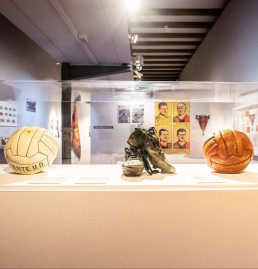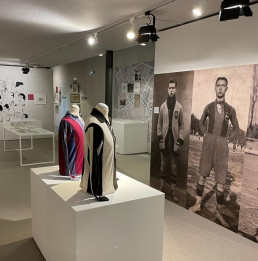The numbers take on significance in this case because of the additional information they offer. Twelve thousand people came to L’ETNO to visit the iconic exhibition ‘DE GRANOTAS, GATS I PALMERES, els orìgens del Levante UD’. The data confirmed by the ‘Departament de Difusió Cultural, Didàctica i Comunicació’ of the Museu Valencià d’Etnologia are revealing and reaffirm the remarkable interest aroused by this exhibition produced by L’ETNO in close collaboration with Levante UD, through the Historical Heritage Area of the Granota institution, and the Culture Area of the Diputació de València. The exhibition, which covered the temporary space sequenced between December 2022 and September 2023, after the additional extension granted during the months of July and August, formed part of the walls of Room X of the exhibition hall of the winner of the award for the best European museum of the year 2023.
The figure presented is the sum total of the total number of visitors who passed through the L’ETNO facilities during the opening period of the expo, as well as the various groups registered and those attending the emotional opening ceremony of this event which took place on the evening of 22 December 2022. By months, June 2023 was the most productive month with 1537 visits. January and February 2023 are on the podium of the most fruitful months with 1364 and 1255 attendees, although it should be noted that up to 802 spectators covered the period between the premiere of this exhibition, 22 December, and the day that marked the official farewell of 2022. In percentage terms, the last days of December registered the highest number of spectators. This is not a trivial period. In this cycle, the influence of the Christmas festivities and the ascendancy that motivated the premiere of this exhibition converged to produce the most successful records.
The figures highlight the interest aroused by this collection which tried to rescue the antithetical origins, from an ideological and also social and economic point of view, of Levante FC and Gimnástico FC and the convoluted and traumatic merger, after the end of the Civil War, as a prelude to the birth of UDLG (Unión Deportiva Levante-Gimnástico), finally christened Levante UD in June 1941. The exhibition offered copious information about the legendary founders of Levante FC and Gimnástico FC, the grounds where both teams played, the format of the old shirts, the titles (with special emphasis on the significance of the Copa España Libre), the merger and the nascent entity after the war conflict, the relations between the players and the club, until reaching the stadium that meant the longed-for transfer to the First Division in the 1962-63 season, when the cat finally climbed the palm tree. The exhibition emphasised the modernity of a pioneering club in its commitment to women’s football and a standard bearer in the consideration of sport as a tool for social inclusion. This exhibition curated by José Vicente Aguilar and Asunción García, curators of L’ETNO; and by Emilio Nadal and Borja Arce, members of the Levante UD Heritage area, with design by Suso Pérez (Estudio Gimeno Gràfic) is included in the historical memory of Levante UD.

